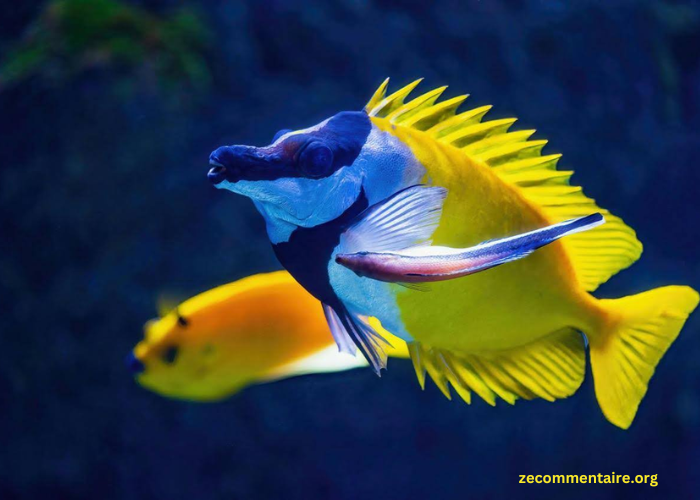If you want to add a dashing marine species to your aquarium, the Foxface Rabbitfish could be the star you’re missing. They are known for their striking appearance and peaceful demeanor. Foxface rabbitfish are popular among saltwater aquarium hobby.
Yet, they also need specific care. Understanding what it takes to keep these dazzling creatures healthy is vital. Read on to learn more.
Foxface Rabbitfish Personality and Characteristics
Foxface Rabbitfish sport earthy tones of brown, black, and white. Their striking blue lines and spots stand out in any reef setup. Their docile and friendly nature makes them a great addition to a community tank.
The name “rabbitfish” stems from their rabbit-like appearance. A protruding mouth and long “whiskers” (barbels) resembling a hare’s face. They can erect to defend themselves against predators.
Can Foxface Rabbitfish Live with Coral?
Yes, Foxface Rabbitfish are generally safe to keep with various coral species. Making them excellent inhabitants of reef tanks. Yet, their grazing habits mean they may nip at certain soft corals if not fed.
How Long Do Foxface Rabbitfish Live?
With proper care, Foxface Rabbitfish can live up to 5 to 7 years in captivity. Maximizing their lifespan requires the following:
- balanced diet
- adequate space
- clean environment
Are Foxface Rabbitfish Easy to Care For?
Foxface Rabbitfish need moderate care, making them suitable for aquarists with some experience. Attention to their dietary needs, tank requirements, and health monitoring is essential. Yet, their peaceful nature and stunning appearance are well worth the effort.
Setting Up the Perfect Foxface Habitat
Creating an ideal environment is crucial. Foxface Rabbitfish are reef dwellers. A tank replicating their natural reef habitat is best.
This means providing plenty of live rock for grazing and seeking refuge. To accommodate their space needs, start with a tank of at least 100 gallons. Its small length is 4 to 6 feet, allowing for adequate swimming room.
A peaceful community of tank mates is essential. Aggressive or large predatory species that could scare should be avoided.
Maintain water temperatures between 72-78°F with a pH range of 8.1 to 8.4 and a specific gravity of 1.020 to 1.025. Invest in a good filtration system and perform regular water changes to keep nitrate levels low.
Diet and Feeding Tips for Foxface Rabbitfish
Foxface Rabbitfish are herbivores in the wild, grazing on algae and seaweed. Mimicking this diet in captivity is vital to their health.
Provide a well-balanced diet of marine algae. Grazing on live rock and a variety of fresh and dried seaweed preparations. They also enjoy blanched vegetables like spinach, zucchini, and green beans.
Supplement their diet with high-quality marine flake food and other vegetable-based marine foods. Feeding several small portions a day is preferred. It aligns with their natural grazing behavior and helps prevent issues.
Behavior and Tank Mates for Foxface Rabbitfish
Foxface Rabbitfish have a calm demeanor, making them an excellent choice for peaceful community tanks. They generally keep to themselves but can become territorial. This is especially true when establishing a feeding or resting area.
Pair them with tank mates that share their temperament, steering clear of aggressive species. Good companions include other peaceful fish, clean-up crews, and invertebrates. Ensure plenty of hiding spots to reduce stress and provide many feeding stations to avoid competition.
Compatibility and Potential Challenges
While aggression isn’t common, a stressed Foxface may show territorial behavior. This can lead to issues if kept in an undersized tank or with incompatible tank mates. Providing plenty of space and a harmonious tank community will help keep your Foxface content.
Another important note is their venomous dorsal spines. They’re not usually a concern in home aquariums, they can cause painful stings if not handled.
Be cautious when conducting aquarium maintenance in the tank. Avoid using a net, opting for a specimen container instead if necessary.
Health and Disease Prevention
Foxface Rabbitfish are generally hardy and resistant to diseases, but like all marine species, they can fall prey to some common health issues. Bacterial infections and parasitic infestations such as ich and fin rot are among the most common.
Regular observation and a proactive approach to health can prevent many common issues. Look for signs of stress, such as loss of color or appetite, and address any potential problems.
Quarantine new additions to your tank to avoid introducing diseases. Look for common marine infections, such as marine ich (white spot disease). Treat as necessary with guidance from a veterinarian or marine specialist.
Changes in water chemistry or temperature can lead to stress and illness. The right diet and a secure environment go a long way in preventing disease in Foxface Rabbitfish.
Breeding Foxface Rabbitfish in Captivity
Breeding Foxface Rabbitfish in a home saltwater aquarium is considered. It is challenging due to their complex spawning behaviors and the need for perfect water conditions.
There have been instances of successful breeding. These cases are rare, and their reproductive process in captivity is still understood.
It should create an environment that mimics their natural habitat with the following:
- ample space
- optimal water quality
- stress-free conditions
Foxface Rabbitfish and Aquascaping
Incorporating Foxface Rabbitfish into an aquarium isn’t about meeting their physical and dietary needs. It’s also about creating an appealing environment that enriches their well-being. Aquascaping, the art of arranging aquatic plants, rocks, and substrates, plays a significant role in achieving this.
When designing an aquascape for Foxface Rabbitfish, consider including various levels and hiding spaces to accommodate their grazing and sheltering habits. Live rock formations that mimic reef outcroppings provide an excellent source of natural algae for the Foxface Rabbitfish to graze on and aid in biological filtration, contributing to the health of the tank ecosystem.
Final Thoughts on Foxface Rabbitfish as Pets
Foxface Rabbitfish bring a captivating presence to any saltwater aquarium. Their diet and overall care are low-maintenance, but they require a thoughtful approach to their environment and tank mates.
If you’re prepared to set up a spacious, well-maintained tank with the right community, a Foxface Rabbitfish could be an enriching addition to your underwater world. Ensure you have the knowledge and resources to keep these beautiful creatures thriving and enjoy the elegant charm they bring to your home reef.
For more helpful tips, check out the rest of our site today!






